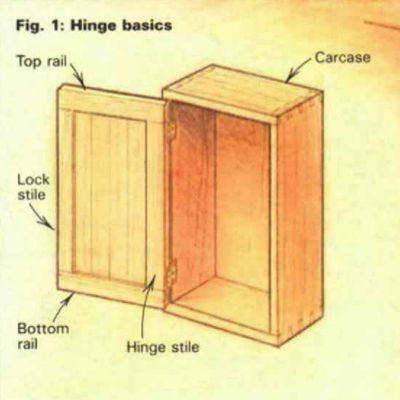
Synopsis: You can hang a door with anything from interlocking clenched nails to plastic inserts, but Roger Holmes prefers solid, extruded brass butt hinges for their nice look and feel. Accurate layout and a careful, step-by-step approach are essential to making them work properly and look right. Extruded hinges are heavier, tighter, and studier than commonly found pressed hinges, and Holmes tells you where to find them. He explains what size to get and in what dimensions they’re usually found, when to add a third hinge, and how to size a door to make the hinge fit best. He mortises the door first and then marks the positions of the hinges on the carcase side using a knife. Extensive drawings illustrate the detailed descriptions of how to finish the hinge installation, and side information covers router mortising Soss hinges.
Hanging a cabinet door well is as important as making it well—unsightly gaps, a sloppy fit or a sticky door can ruin the effect of the loveliest wood and most meticulous joinery. You can hang a door with anything from interlocking clenched nails to space-age plastic inserts. Solid, extruded (or drawn) brass butt hinges have a nice look and feel, and I prefer them for most quality work. Accurate layout and a careful, step-by-step approach are essential to making butt hinges work properly, as well as look nice. Although I will describe how to hang a flush door (one hung inside the carcase, flush with the carcase edges), the steps are much the same for butt-hinging other types of doors, too.
You may have a little trouble finding extruded hinges. Most hardware store brass hinges are stamped or pressed from a single sheet, and the hinge barrels are bent around the pins. Although these hinges are cheaper than the extruded ones, their leaves are thin and often rattle around the pin. Extruded hinges, made by forcing hot brass through dies shaped to the desired cross-section, are generally heavier, tighter and sturdier than pressed hinges. (Extruded brass hinges in a variety of sizes are available from Garrett Wade, 161 Avenue of the Americas, New York, N.Y. 10013.)
Hinges are commonly described by their height and open width, in that order. A 2-in, by 1 in. hinge, therefore, has leaves -in. wide, measured to the center of the barrel. The width of the hinge needed for each door depends on the thickness of the door stile and width of the hinging surface on the carcase. You can figure widths on a full-scale drawing or by trying various hinges against the door itself. If you want a rough general rule, double the thickness of the stile (or carcase surface if it’s narrower) to get the hinge width. A -in. door, for example, can accommodate a 1 :in.-wide hinge. The barrel protrudes beyond door and carcase, allowing the door to swing open and making room for a stopped mortise, which hides the edge of the hinge from view on the door’s inside face. Long hinges give more support, for obvious reasons, but balance length against looks—I seldom use hinges longer than 2 in. on all but the largest cabinets.
The leaves of extruded hinges can be rectangular in section or tapered. A tapered hinge is lighter for the same strength, but the difference is insignificant for cabinet-sized hinges; there are only minor differences in installation. Most cabinet butts I’ve found have been tapered. I recommend fixed-pin hinges for cabinet doors; the convenience of loose-pin hinges, which can be disassembled during installation, is outweighed by the sloppy fit of pin to leaves.
I use two butt hinges for most cabinet doors, adding a third in the middle of doors over 30 in. high.
From Fine Woodworking #58
For the full article, download the PDF below:
Fine Woodworking Recommended Products

Bessey K-Body Parallel-Jaw Clamp

Bessey EKH Trigger Clamps






















Log in or create an account to post a comment.
Sign up Log in